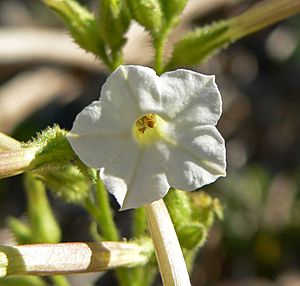Coyote tobacco facts for kids
Quick facts for kids Coyote tobacco |
|
|---|---|
 |
|
| Scientific classification | |
| Genus: |
Nicotiana
|
| Species: |
attenuata
|
Nicotiana attenuata is a type of wild tobacco often called coyote tobacco. It grows naturally in western North America. You can find it from British Columbia down to Texas and northern Mexico. This plant lives in many different kinds of places.
Coyote tobacco is an annual plant, meaning it lives for one year. It can grow taller than a meter (about 3 feet). The plant has sticky hairs. Its leaves can be about 10 centimetres (4 in) long. The lower leaves are oval, and the upper ones are narrower. They grow on small stems called petioles.
The plant's flowers grow in a cluster. They have pinkish or greenish-white tubes. These tubes are about 2 to 3 centimetres (4⁄5 to 1+1⁄5 in) long. Pointed leaf-like parts called sepals cover the base of the flowers. The flower's top part has five mostly white sections. After flowering, the plant makes a fruit that is a small capsule. It is about 1 centimetre (1⁄2 in) long.
Contents
How Coyote Tobacco Lives
Studying the Plant
Scientists have been studying Nicotiana attenuata since 1994. They use it to learn about how plants interact with nature. This plant has many connections with other plants, insects, and tiny living things.
Researchers at the Max Planck Institute for Chemical Ecology in Jena, Germany, do a lot of this work. They use special tools to study the plant's genes and how it acts in its natural home. They also do field work in the Great Basin Desert. This helps them understand how coyote tobacco interacts with its environment.
Plant Eaters
Two types of hornworms like to eat N. attenuata. These are the tobacco hornworm and the tomato hornworm. These worms do not like high amounts of nicotine in the plant's leaves. The tobacco hornworm reacts even more strongly to nicotine. The amount of nicotine and other insect predators help decide where the hornworms will eat on the plant.
How Coyote Tobacco Defends Itself
N. attenuata has ways to protect itself from being eaten. It uses both direct and indirect defenses. Its main enemies are the tobacco hornworm and tomato hornworm larvae.
Direct Defenses
When these worms eat the tiny hairs on the tobacco leaves, the plant makes special proteins. These are called trypsin proteinase inhibitors. They make it harder for the hornworms to digest the plant material. This weakens the worms.
Indirect Defenses
The plant also has indirect ways to protect itself. When larvae eat the leaves, the plant releases certain smells. These are called green leaf volatiles (GLVs). These smells act like a signal. They attract Geocoris bugs, which are predators of the hornworms.
These GLVs are part of many smells the plant releases when it's being eaten. When hornworm saliva mixes with the GLVs, the smells change. This change makes them even more attractive to Geocoris bugs. This helps the bugs find and eat the hornworm eggs and larvae. Wild tobacco can also sense smells from other plants nearby. This helps it get ready to defend itself.
Another clever defense is changing when its flowers open. Normally, N. attenuata flowers open at night. This is when hawkmoths visit them for pollination. Hawkmoths also lay their eggs on the plant at night. These eggs hatch into the hungry hornworms.
But if hornworms eat the plant, their saliva causes changes inside the plant. This makes the plant reduce a smell that attracts hawkmoths. It also makes the flowers open in the morning instead. This way, day-active hummingbirds pollinate the flowers instead. This shift helps the plant avoid future attacks from hawkmoth larvae.
Scientists found this amazing change in a group of N. attenuata plants in Utah. They put mesh covers over some plants. Some had hornworms, and some did not. After just 8 days, plants with hornworms had many more flowers opening in the morning.
These defenses show how flexible N. attenuata is. It can change its behavior to fight off attacks from plant-eating insects.
Uses by People
This plant was very important to many Native American groups. They used it for many medicinal purposes. They also smoked it in special ceremonies. Groups like the Hopi, Apache, Navajo, and Paiute used it this way.
The Zuni people had a special use for it. They would blow the smoke over a person's body. They believed this helped reduce the throbbing pain from a rattlesnake bite. They also smoked it in their ceremonies.
Images for kids
See also



